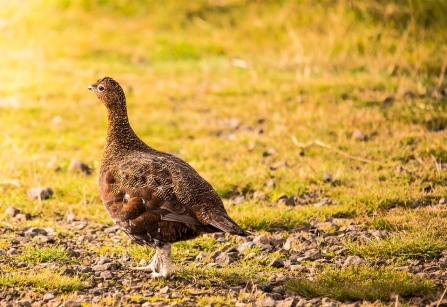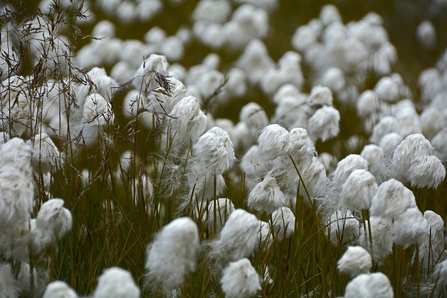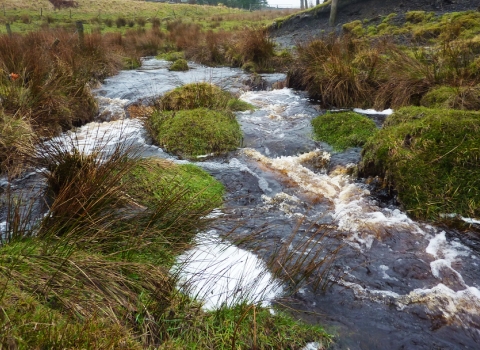Creating a thriving moorland
Staffordshire Wildlife Trust looks after 43 nature reserves across the length and breadth of the county, managing them to provide much-needed refuge for our amazing wild birds, mammals, insects, reptiles and amphibians.
Over the last 100 years, huge tracts of prime wildlife habitat have been lost – so conserving and connecting what we have left is crucial if we want wildlife to survive for future generations to enjoy.
The moorland that makes up Black Brook is one of these surviving remnants of precious habitat. But when we purchased the site back in 1996 it wasn’t in very good ecological condition and as a result there weren’t many species of wildlife there. So we set about restoring the moorland and creating broadleaf woodland.
Moorlands are amazing! Did you know...
- On a global scale, moorland is rarer than tropical rainforest - and 75 per cent of it is in Britain.
- Wild open moorlands may appear bleak, but they are home to a wealth of wild birds, plants and animals. Rare species such as red grouse, a stunning game bird with bright red eyebrows, green hairstreak, a small butterfly with brilliant emerald wings and wispy cotton-grass depend on this habitat for their survival.
- Over the last 50 years, we have lost 40 per cent of moorlands to commercial forestry and inappropriate intensive grazing.

Our vision
Before the Trust acquired the reserve, a forestry company planted around 100 acres of the land with conifers for timber production. But the trees were never harvested, and were left standing in dense rows. These gloomy conifer plantations have limited value for wildlife - the thick canopies of conifers block out light from the forest floor, making it difficult for woodland plants and insects to survive.
Since acquiring the land the Trust has made progress towards restoring most of the conifer plantation back to moorland and has planted thousands of broadleaf trees - native trees like oak, rowan and hazel, which support a greater variety of wildlife.
The project was approved by the Forestry Commission following the production of a full Environmental Impact Assessment.

What we’ve achieved so far
The Trust began restoring the landscape at Black Brook back in 2002, and the benefits are already apparent. Areas of land which used to be plantation are now carpeted in moorland plants, such as delicate cotton-grass and bilberry. Over 9,000 broadleaf trees have been planted so far, and these areas are establishing well and on their way to becoming the broadleaf woodland of the future.
Commercial crop to wildlife haven
As the conservation project progresses, we’ll start to see the landscape recover and a wider variety of wild species will continue to move in to Black Brook.
A wide range of wildflowers and plants are thriving in the new open and woodland areas, such as orchids, bog asphodel, sphagnum moss and water avens. Moorland insects, such as the beautiful green hairstreak butterfly and the rare moorland bumblebee will be able to colonise the restored landscape.
Frequently asked questions
Why couldn’t the plantation be left as it was?
As well as being a poor wildlife habitat, the conifer plantation was nearing the end of its natural lifespan. The trees were grown for timber and planted close together in rows. Some trees have already fallen down, bringing down neighbouring trees with them. The jumble of trees that remain are unsightly, dangerous and difficult and costly to remove. The Trust doesn’t want to wait for this scenario on a large scale, so needs to harvest the trees within 10 years. This also means that the timber can be put to good use, and used as woodfuel for example.
Why has the Trust put up a deer fence?
We have installed a fence around the new trees that have been planted to protect them from being eaten by deer and give them the best chance of survival. The deer will be able to forage elsewhere. Once the trees are established and the fence is removed, the deer will return.
Will the wildlife in the reserve change as a result of the project?
The aim of the restoration work was to attract a wider variety of wildlife to Black Brook, including many species which are at risk. We have already seen red grouse, a declining moorland bird, moving into the areas that were restored to moorland in 2002.
Delicate cotton-grass, a rare moorland plant, is also thriving in these areas, and as more plants become established over time, insects such as the green hairstreak butterfly and moorland bumblebee will start to colonise it too. Wide areas of open space now support moorland plants such as heather and bilberry.
Due to the changing habitat, some common bird species such as wood pigeon, carrion crow and chaffinch may leave the reserve for other areas, while rarer species such as lesser redpoll and willow warbler are expected to move in.
Here is a list of species that will benefit from the Black Brook conservation project:
Birds: Lesser redpoll, willow warbler, songthrush, bullfinch, tree pipit, dunnock, dipper – these species will benefit from the diversity of habitats which will be restored and created during the project.
Mammals: Water shrew and voles will increase in number as more open ground is provided. These will provide an additional food source for larger mammals) and birds of prey such as kestrels and hobbies.
Butterflies: Green-veined white and green hairstreak will benefit from an increase in their favoured food plants to increase, such as bilberry.
Damselflies/dragonflies: Clearing trees along watercourses and creating new boggy pools will provide open areas for dragonflies and damselflies to increase in numbers.
Flora: Bog asphodel, sphagnum moss, cranberry and cotton grass.
How can I support this work?
If you would like to support Staffordshire Wildlife Trust’s work, you can become a member by joining online or calling 01889 880100 during office hours.

